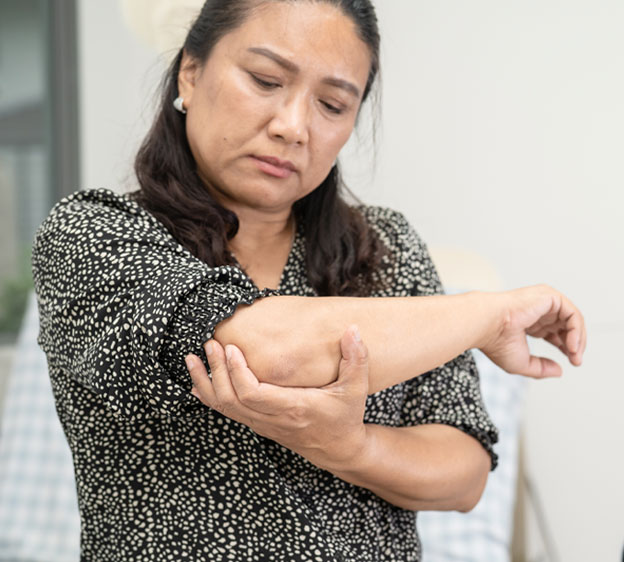
Your elbows are some of the body’s hardest-working joints. You depend on them for countless tasks, from eating to writing, typing to playing with your children or grandchildren. Consequently, when injuries occur, they can throw you for a loop. Help reduce elbow pain and keep your elbows flexible and dependable by taking steps to reduce your risk for five common elbow injuries.
1. Tendinitis
It’s difficult to pinpoint the most common elbow injury, but it might well be tendinitis. Also known as tennis elbow or golfer’s elbow, elbow tendinitis is inflammation of or injury to tendons in the elbow joint.
“Elbow tendinitis is a common sports injury,” says Dr. Vandit Sardana, a board-certified orthopedic surgeon at Beaufort Memorial Orthopaedic Specialists. “Over time, swinging a tennis racket or golf club repeatedly can inflame or stress the tendons in your elbow. Golfers and tennis players aren’t the only ones at risk for elbow tendinitis, though. If you use your hands, wrists or forearms intensively at work, you’re more vulnerable to this condition.”
Elbow tendinitis can cause pain and make it difficult to grip objects. If you’re experiencing symptoms, an orthopedic specialist can determine whether you need to be treated for tendinitis. You may be able to reduce your risk for this condition and other elbow overuse injuries by stretching and strengthening your wrists and forearms.
Before starting a recovery program, ask an orthopedic specialist or physical therapist what’s appropriate for you. To stretch your wrists and lower arms, extend one arm in front of you with the wrist bent up. Use the opposite hand to gently pull your hand backward until you feel a stretch in your forearm. The American Academy of Orthopaedic Surgeons (AAOS) recommends repeating this exercise five times with each hand, four times per day.
To strengthen your wrist and forearm muscles, rest your forearm on a table, elbow bent, and slowly perform wrist curls using a 1- to 3-pound weight. Over time, you can gradually straighten your elbow and lift your arm off the table. The AAOS recommends performing 30 repetitions with each arm per day.
Read More: Head Off Sports Injuries Before They Happen
2. Bursitis
Elbow injuries can affect any part of the joint, including small, fluid-filled sacs called bursae. As they do in other joints, the bursae help soft tissues in your elbows move smoothly over bone. When inflammation affects the bursae, they fill up with fluid, which causes pain and swelling. This condition is known as elbow bursitis.
Certain elbow bursitis risk factors are largely outside of your control. These include elbow trauma and infection. However, that doesn’t mean you’re completely powerless. Steps you can take to avoid bursitis include:
- Not leaning on your elbows, especially when typing
- Strengthening your elbows and warming up before physical activity
- Wearing elbow pads while playing sports or working with your arms
3. Osteoarthritis
Some elbow injuries develop gradually and have long-term effects. That’s the case for osteoarthritis of the elbow.
Many people associate osteoarthritis — the wearing away of cartilage — with knees and hips, but it also affects other joints, including the elbows. Symptoms include pain and reduced range of motion.
In most cases, osteoarthritis of the elbow occurs due to wear and tear from years of use. Sometimes, however, a fracture or other injury is to blame. Consequently, the main way to reduce your risk of elbow osteoarthritis is to take steps to prevent an elbow injury in the first place. These include wearing elbow pads when appropriate and performing exercises to strengthen the surrounding muscles.
4. Elbow Sprain
Bending or twisting your elbow beyond its normal range of motion — or overusing it — can cause a sprain. This is when you pull or tear one of the joint’s ligaments. The key to reducing your risk is to help keep the joint strong and flexible. To do that, perform exercises to build up the muscles around the elbow, and be sure to stretch before exercising or working with your elbows.
Importantly, give your elbows a break from repetitive movement, if possible. For example, if you love tennis, take a day or two off during the week and rest or try other sports. That will help you avoid overuse.
Read More: A Primer on Preventing Bone and Joint Problems
5. Cubital Tunnel Syndrome
Cubital tunnel syndrome — also known as ulnar nerve entrapment — affects the ulnar nerve, one of the main nerves in the arm. Compression, or squeezing, of the nerve commonly occurs in the elbow. This can happen due to repeated bending of or pressure on the joint. Other causes include fluid accumulation and hitting your funny bone.
Cubital tunnel syndrome can cause intermittent numbness in your ring and little fingers. To lower your risk:
- Don’t overuse your elbow or keep it bent for too long.
- Keep your arm straight while sleeping.
- Perform exercises to strengthen your arm.
- Wear protective equipment to reduce your risk of elbow fracture or dislocation.
Request an appointment to discuss your elbow pain with a Beaufort Memorial orthopedic specialist.

